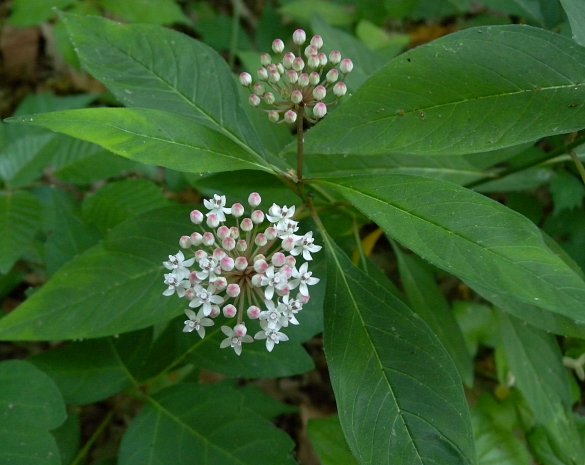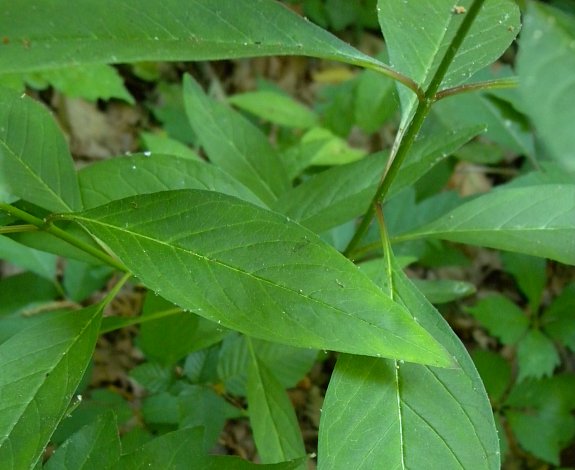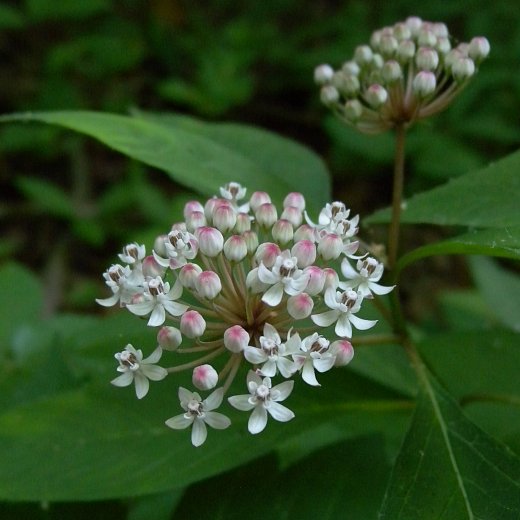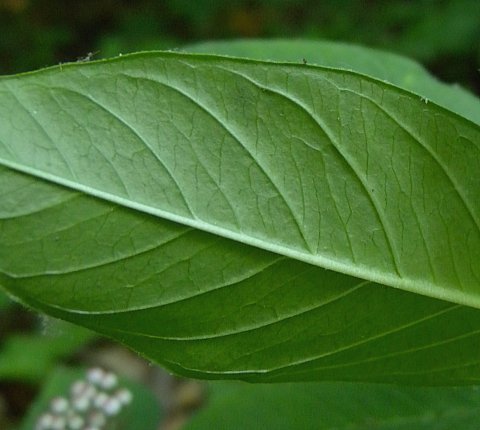
One or more umbels of flowers about 1½-2½" across are produced from the axils of the upper leaves; each umbel has 20-50 white to pinkish white flowers. The umbels are held more or less erect on rather stout peduncles about ½-2" long. Each flower is about ¼" across, consisting of 5 corolla lobes (or petals), 5 sepals, 5 hoods with horns, and a central reproductive column (gynostegium). The reflexed corolla lobes are generally white, although they are often pinkish along the undersides towards their tips. The white hoods are erect and scoop-shaped; the horns of these hoods are slender, curved slightly inward, and exerted. The inconspicuous sepals are pale green or pale purplish green, lanceolate-oblong in shape, and shorter than the corolla lobes. The pedicels are ¾-1¼" long, whitish green to pale purplish green, terete, and minutely pubescent. The blooming period occurs from late spring to mid-summer (or sometimes later), lasting about 1-2 months. The flowers are mildly fragrant. Afterwards, fertile flowers are replaced by lanceoloid seedpods (follicles) about 2½-3" long. The outer surfaces of these seedpods are smooth and glabrous. Immature seedpods are held erect, but they droop downward at maturity to release their seeds. These seeds have expanded coats, but they lack comas (tufts of hair); they are capable of floating on water for extended periods of time, thereby distributing them to new locations (Edwards et al., 1994). The root system consists of a woody crown. Decumbent stems on moist ground can develop rootlets, forming clonal offsets.

Cultivation: The preference is partial sun to medium shade, wet to consistently moist conditions, and soil containing abundant organic matter. Standing water is tolerated if it is temporary.
Range & Habitat: The native White Swamp Milkweed (Asclepias perennis) is occasional in southern Illinois, while in the rest of the state it is absent (see Distribution Map). Illinois lies along the northern range limit of this species. Habitats include floodplain and bottomland woodlands, swamps (including Bald Cypress swamps), borders of ponds and streams in shady areas, and ditches. This milkweed is usually found in higher quality wetlands that are semi-shaded to shaded.

Faunal Associations: Little is known specifically about the floral-faunal relationships of White Swamp Milkweed (Asclepias perennis). The white flowers are probably cross-pollinated by various bees, wasps, butterflies, and moths. The floral reward of such visitors is nectar. Other insects feed on the foliage, seeds, roots, plant juices, and other parts of milkweeds. These insect feeders include stem- and root-boring larvae of Tetraopes tetrophthalmus (Red Milkweed Beetle), stem-boring larvae of the weevil Rhyssomatus lineaticollis, Labidomera clivicollis (Swamp Milkweed Beetle), Lygus kalmii (Small Milkweed Bug) and Oncopeltus fasciatus (Large Milkweed Bug), several aphid species, caterpillars of the butterfly Danaus plexippus (Monarch), and caterpillars of a few moths (see the Insect Table for a more complete listing of these species). Because the milky latex of the foliage is bitter-tasting and toxic, White Swamp Milkweed and other milkweeds are rarely eaten by mammalian herbivores. However, the seeds are a minor source of food to the White-Footed Mouse (Whitaker, 1966).
Photographic Location: A swamp in southern Illinois.

Comments: This is one of several white-flowered milkweeds (Asclepias spp.) in Illinois. It differs from these other species by its preference for shaded wetland habitats. The only other milkweed within the state that reliably prefers wetlands, Asclepias incarnata (Swamp Milkweed), is a taller plant with pink flowers; it also prefers wetlands that are more sunny. White Swamp Milkweed (Asclepias perennis) is unique among milkweeds within the state by its seeds, which lack comas (tufts of hair). Instead of wind-distribution, this milkweed relies on water to distribute its seeds to new locations. In addition to this characteristic, White Swamp Milkweed can be distinguished from other white-flowered milkweeds by the shape of its leaves, which are more narrow than those of Asclepias variegata (White Milkweed), but more broad than those of Asclepias verticillata (Whorled Milkweed). However, across its range, the leaves of White Swamp Milkweed can vary significantly in their average width. Another common name of Asclepias perennis is Thin-Leaved Milkweed.